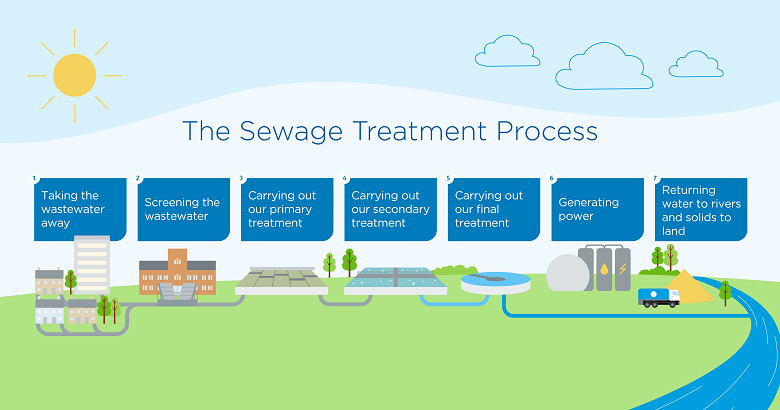Strategic Approaches to Improve Drainage Treatment Effectiveness and Lessen Ecological Effect
In the realm of waste water therapy, the pursuit for boosted performance and lowered ecological influence is a perpetual difficulty that requires strategic options. As culture grapples with the essential to take care of water sources sustainably, a nuanced approach comes to be important. The assimilation of innovative therapy technologies, energy-efficient procedures, source recuperation approaches, boosted nutrient removal methods, and smart tracking and control systems represents a diverse structure for addressing these pushing issues. Nonetheless, what lies at the core of this complicated web of methods is the prospective to transform the way we approach drainage treatment, not equally as a process of disposal, however as a beneficial opportunity for development and environmental stewardship.
Advanced Therapy Technologies
Advanced membrane layer filtering systems have actually transformed sophisticated wastewater treatment procedures, considerably boosting the removal of contaminants. These ingenious systems work forcibly water through a semi-permeable membrane layer, efficiently dividing contaminations from the water stream. The membrane's tiny pores catch toxins such as bacteria, infections, and put on hold solids, enabling only cleansed water to travel through. This technology has actually shown to be very reliable in eliminating a wide variety of impurities, including pharmaceuticals, heavy steels, and natural compounds, which are typically challenging to get rid of with standard therapy approaches.
Furthermore, membrane filtration systems supply countless advantages over conventional treatment strategies. Additionally, these systems are extremely versatile and can be quickly incorporated right into existing treatment plants or made use of as standalone systems for decentralized applications.
Energy-Efficient Processes
The combination of energy-efficient procedures in wastewater therapy systems is essential for optimizing resource utilization and minimizing operational costs. By executing energy-efficient innovations, treatment plants can dramatically reduce their carbon impact and general environmental impact. One essential technique to improving energy efficiency in wastewater therapy is the utilization of sophisticated aeration systems, such as great bubble diffusers or surface area aerators, which can enhance oxygen transfer efficiency and lower power usage. Additionally, integrating energy recuperation systems, like anaerobic food digestion for biogas production or using excess warmth for thermal processes, can help offset power demands and advertise sustainability.
Furthermore, enhancing process control and automation through the usage of sophisticated sensing units and monitoring systems can enhance general power efficiency by changing operations in real-time based upon actual need and problems. Executing power audits and on a regular basis keeping track of power efficiency indicators are essential techniques to recognize areas for improvement and track energy-saving efforts properly. Overall, the adoption of energy-efficient processes in wastewater therapy not just profits the atmosphere but likewise adds to lasting expense financial savings and functional sustainability.
Resource Recovery Strategies
With a concentrate on enhancing resource utilization and sustainability in wastewater therapy systems, the execution of resource recuperation approaches arises as a critical facet in enhancing functional effectiveness. Source recovery techniques in wastewater therapy entail the recognition and extraction of valuable sources from the waste stream, thereby turning what was when taken into consideration waste right into an important possession. By executing resource recuperation methods such as nutrient removal and healing, power generation from organic matter, and the manufacturing of multiple-use water, wastewater treatment plants can minimize environmental impact while making the most of effectiveness.

Improved Nutrient Removal Techniques
Implementing sophisticated nutrient removal techniques is crucial for maximizing the effectiveness of wastewater therapy systems. One of the key methods utilized for improved nutrient elimination is the process of biological nutrient elimination (BNR), which includes the removal of nitrogen and phosphorus with biological processes.

In addition to BNR, advanced therapy methods such as membrane bioreactors (MBRs) and constructed marshes can also be utilized to enhance nutrient removal performance. By including these innovative nutrient removal techniques into wastewater therapy markets, systems and towns can effectively lower nutrient pollution and shield the setting.
Smart Tracking and Control Equipment
Making use of advanced technology, the combination of smart tracking and control systems reinvents the operational efficiency of wastewater therapy facilities. These systems include innovative sensors and information analytics to constantly keep track of essential parameters such as pH levels, turbidity, dissolved oxygen, and flow rates in real-time. By gathering and evaluating this information, drivers can acquire important insights into the performance of the therapy Bonuses procedures, making it possible for aggressive adjustments to enhance therapy effectiveness.
Smart tracking and control systems likewise support remote surveillance capabilities, permitting operators to gain access to real-time data and control features from off-site places. This remote availability improves functional versatility and responsiveness, making it possible for quick interventions in situation of system malfunctions or changes in influent quality. Additionally, the anticipating upkeep capacities of these systems aid prevent devices failures and lessen downtime, ultimately improving the general integrity of wastewater treatment operations (Waste Water Treatment).
Final Thought
Finally, tactical methods such as sophisticated therapy technologies, energy-efficient procedures, source recovery methods, improved nutrient removal strategies, and wise monitoring and control systems play a vital function in enhancing wastewater treatment effectiveness and reducing ecological impact. By executing these strategies, wastewater treatment plants can improve their total performance, minimize power usage, recover valuable sources, and guarantee conformity with environmental policies. These approaches are crucial for sustainable and efficient wastewater administration methods.

In verdict, tactical methods such as sophisticated treatment modern technologies, energy-efficient procedures, resource recovery methods, enhanced nutrient elimination techniques, and clever surveillance and control systems play a critical duty in enhancing wastewater treatment efficiency and minimizing environmental influence.